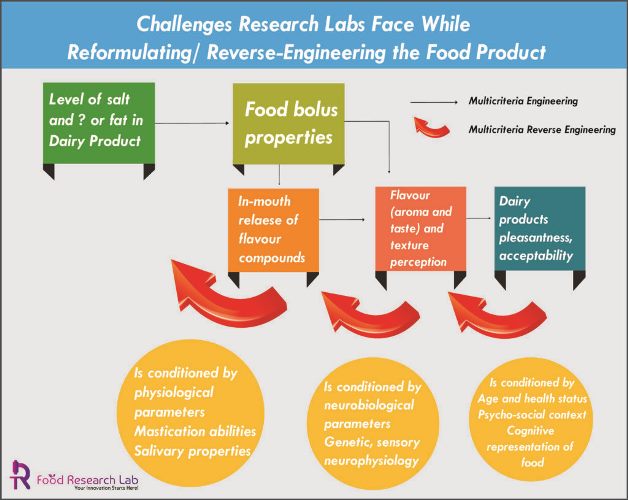
Challenges to the research labs in reformulating/ reverse-Engineering the food product for improved health
Brief:
The methods and evolution of continuous process and products that incorporate technical and economic criteriato satisfy customers demand, and safeguard ecosystem is the biggest challenge in the broad context of global change.
- Reformulating/reverse engineering is useful in various fields; it commonly refers to the process that consists of designing manufacturing conditions according to desired end-product properties.
- For reformulating/ reverse-engineering to undergo the food product for improved health, we have more experts. The Food research lab will help to deliver more specific services like new product development, food consulting services etc.
Introduction
Enormous adsorption of energy, salt, saturated fat and sugar leads to a high risk of diseases, such as cardiovascular diseases, diabetes and cancer. The World Health Organisation claims the private sector to advance the food supply and reduce the level of unwanted energy density, cholesterol, saturated fat, and extra added sugar in their products.Reformulating has been huge on the list of public health and food consultancies. Reformulating/reverse engineering is defined as the “Discount of the amount of harmful nutrient in refined foods”.
The particular challenges:
Possible food science and technology to enhance the new food product development
- Fat reformulation
- Salt reformulation

Each of these is brought with particular challenges in terms of the impact of the nutritional modification on Flavour and consumer acceptability, Demand of the product, Factors affecting product safety,Shelf life. Processing characteristic that can, in turn,involve product cost. The resulting matrix is a complicated one, and broad information is available on each modification of individual nutritional improvement opportunities versus the effect of each of these on new productdevelopment in food industries. However, it is necessarywhichcan be used as a tool kit when corresponding with nutritionists and other colleagues in the food community. They may lose a detailed understanding of the practical implication of nutritional enhancement.
Fat reformulation:
Fat reduction/ reformulation can be replaced by various products like, by adding protein, carbohydrate, non-metabolic lipids, air and waters. The changes of fat with protein and carbohydrate-based has been a significant area of activity for the innovative food companies, and Results have been mixed with a fair degree of success achieved in areas such as baked goods and specific group of dairy products. However, the particular characteristics of fat are such that substitute of fat with protein and carbohydrate in those products where its physical characteristics supply fundamentally to the composition and processing characteristics of the product, such as fried products, biscuits and chocolate, is not technically feasible. Cost of the reformulation is often higher than that of the fats being replaced. By concluding, fat reformulation is a well-established technology, but value and service limit its usage infood product development companies.
.Salt reformulation
It is a known source that it has to prove a virtual moment to match the flavour characteristics of salt, both in absolute terms and also in terms of its ability to enhance other flavours within a food system. The use of potassium chloride is a well-settled method. Still, its extract is not always standardand often transmit bitter tastes to the food in which it is used, as well as being naturally more expensive than salt. The objection in this field of food consulting services, if the salt reduction is desired, it is like a more desirable solution to progressively reduce the amount of salt in reformulated diet in stages and develop the consumer to accept lower salt levels.

Conclusion:
Product reformulations, for example, reduction of salt, fat or sugar content, represent significant challenges for food manufacturers, but food research lab can help to overcome these challenges. For this purpose, with the use of scientific methods, a food research lab is built with which the properties of a product and any changes to them can be objectively qualified and quantified. In this way, beverage product development and innovation can be accomplished in a much faster and more goal-orientated way, putting manufacturers in a better position to conquer their market.
References
- Yach, D. 2005; Preventing Chronic Disease; Annals of Nutrition & Metabolism: 49(Suppl I),50
- Irz X, Leroy P, Réquillart V, Soler L-G (2016) Beyond wishful thinking: Integrating consumer preferences in the assessment of dietary recommendations.
- Vandermoere F, Blanchemanche S, Bieberstein A et al. (2011) The public understanding of nanotechnology in the food domain: the hidden role of views on science, technology and nature.
- World Health Organisation. Regional Office of Europe. Copenhagen: 2008.
- Hendriksen M., Etemad Z., Van den Bogaard C.H.M., Van der A D.L. Zout-, Jodium-en Kaliuminname 2015





